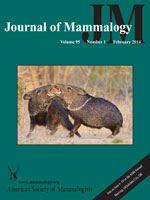The Great Basin pocket mouse, Perognathus parvus, inhabits temperate shrub-steppe and arid grassland biomes throughout the Columbia Plateau, Great Basin, and adjacent regions of western North America. We used both mitochondrial DNA (mtDNA) and nuclear DNA (nDNA) sequences to address phylogenetic and biogeographic structure within the P. parvus species group. Phylogenetic and biogeographic analyses divide haplotypes from the mtDNA cytochrome oxidase subunit 3 (COIII) gene into largely allopatric northern versus southern lineages (clades), with divergences of up to 18.8%. The southern mtDNA clade also includes at least 1 of the 2 recently extant populations of the white-eared pocket mouse, P. alticolus—an endangered species with a restricted range in southern California. The northern mtDNA clade is further subdivided into several additional lineages with divergences as high as 8.8%, whereas the southern clade has no divergence greater than 1.2%. The deeper mtDNA gene tree structure was recovered by use of nDNA exon sequences from the interphotoreceptor retinoid-binding protein (IRBP) and recombination activating gene 2 (RAG2) gene regions, supporting a “gene tree–species tree” congruence. We estimated through molecular clock analyses that the northern and southern clades likely diverged within a late Miocene time frame. The limited available karyological evidence is consistent with a genome-wide divergence between northern and southern clades—thus, is consistent with recognition of each as a separate species. Conversely, our morphometric analysis revealed a high level of morphological conservatism without detectable diagnostic differences, rendering them as “cryptic” species. We revised species-level taxonomy, designating 2 neotypes given apparent loss of original type specimens. We postulate that barriers associated with Columbia Plateau, Snake River Plain, and Great Basin physiographic evolution, during a Neogene time frame, resulted in persistent geographic isolation driving divergence between the northern and southern clades.
How to translate text using browser tools
1 February 2014
Cryptic divergence and revised species taxonomy within the Great Basin pocket mouse, Perognathus parvus (Peale, 1848), species group
Brett R. Riddle,
Tereza Jezkova,
Mallory E. Eckstut,
Viktória Oláh-Hemmings,
Leslie N. Carraway
ACCESS THE FULL ARTICLE

Journal of Mammalogy
Vol. 95 • No. 1
February 2014
Vol. 95 • No. 1
February 2014
biogeography
Columbia Plateau
Great Basin
Heteromyidae
mitochondrial DNA
neotype
nuclear DNA




